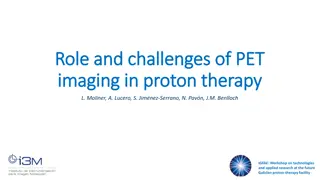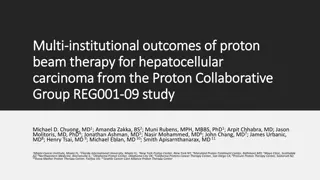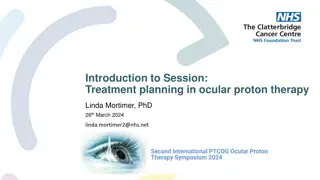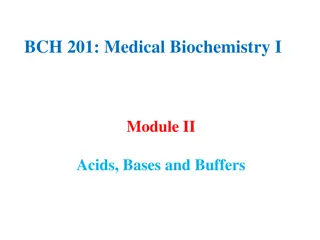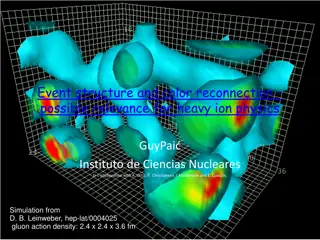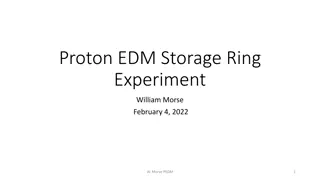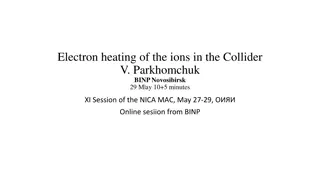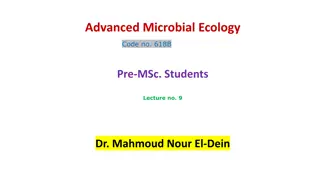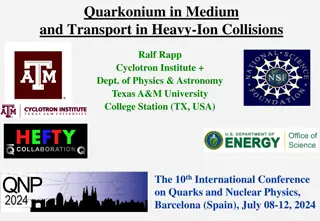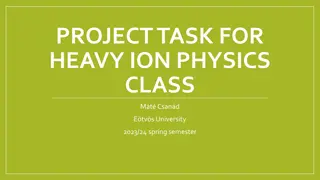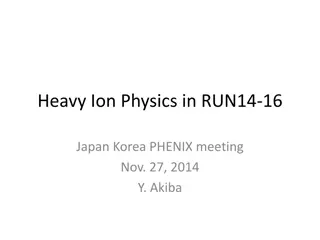Rapid Health Technology Assessment on Proton and Heavy Ion Therapy in China
This assessment evaluates the clinical effectiveness, allocation necessity, and cost-effectiveness of proton and heavy ion therapies in China, considering the heavy tumor burden of diseases and the high demand for radiation therapy in the country. The study outlines policies, medical devices, regulations, and the management of particle therapy centers in over 40 cities. It also discusses the methodological framework for conducting a rapid review to assess the dimensions, contents, and methods of health technology assessments and systematic reviews.
Download Presentation

Please find below an Image/Link to download the presentation.
The content on the website is provided AS IS for your information and personal use only. It may not be sold, licensed, or shared on other websites without obtaining consent from the author.If you encounter any issues during the download, it is possible that the publisher has removed the file from their server.
You are allowed to download the files provided on this website for personal or commercial use, subject to the condition that they are used lawfully. All files are the property of their respective owners.
The content on the website is provided AS IS for your information and personal use only. It may not be sold, licensed, or shared on other websites without obtaining consent from the author.
E N D
Presentation Transcript
Rapid health technology assessment on proton and heavy ion therapy in China Michelle Li 20thFeb., 2017, Xiamen
Background Objectives Design and methods Results
Background Heavy tumor burden of disease survival population within 5 years is 7.49 million treatment expenses is over 17.6 billion per year. Large radiation therapy (RT) demand 50-70% patients with cancer need RT CNHDRC was commissioned by the Division of Medical Science and Education, China National Health and Family Planning Commission (NHFPC, former MoH) to evaluate proton and heavy ion therapy s clinical effectiveness, allocation necessity and cost-effectiveness.
Proton and heavy ion therapies in China Policies Medical Devices and Regulation on Proton and heavy ion radiation therapies More than 40 cities in China are planning to establish treatment centers Table 1 Particle therapy in China Management Regulation on Allocation and Application of Large Number of City Institution Particle Application time Cancer type patients Head and neck Shandong Zibo Proton cancers, lung cancer, 2004 2004 1078 1078 wanjie Hospital rectum cancer Head and neck Institution of Lanzhou Heavy ion cancers, chest 2006 2006 213 213 modern physics cancers Head and neck Shanghai PHIT Proton and Shanghai cancers, lung cancer, 2014 2014 169 169 Hospital heavy ion rectum cancer
Methodological framework for conducting the rapid review dimensions contents methods HTAs and SRs RCTs and other studies systematic review Clinical efficacy & safety Cost- Literature review on costs, comparative , cost-benefit; Expert consultation: international experts in HTA organizations and decision-making agencies; Cost analysis; Cost-effectiveness; effectiveness/relati ve cost- effectiveness/cost- benefit International experiences concerning management and use of the tech.; Social and ethical analysis; Budget impact analysis; Literature review: technological appropriateness; introduction, application, supervision and management of the technology in other countries; indicated patients, their distribution and characteristics in China; technology diffusion and use of alternative technology in China; costing and budgetary implication analysis; Expert consultation: domestic and international experts in related fields; Modeling and budgetary analysis Implications of technology use on health sector and society (inc. social and ethical considerations)
Evaluation methodOHRI rapid review Needs assessment (week 1) Write proposal Question development and refinement (week 3) (week 2) Literature search and expert consultation (week 4) Narrative synthesis (week 5-7) Screening and selection of studies (week 5) Based on literature review combine site investigation, expert consultation and key formant interviews Report production week 8 Ongoing follow- up with end users week 9
Database Database Article database Systematic review and HTA database Cochrane Library University of York CRD database HTA websites AHRQ ICER NICE NIHR CADTH MSAC SBU NECA International guidelines Searching deadline 12, Nov, 2015 CNKI PubMed ISI NICE NCCN
Search terms Chinese English "Proton carbon ion Therapy"[Mesh] proton/heavy ion/carbon ion therapy proton/heavy ion /carbon ion therapy beam proton/heavy ion/carbon ion radiotherapy proton/heavy ion/carbon iontherapy charged particle therapy hadron therapy hadrontherapy Systematic review meta analysis randomized clinical trial comparative clinical trial economic evaluation cost- effectiveness analysis horizon scanning appraisal review health technology assessment guidance guideline meta
Findingsclinical effectiveness: proton beam therapy (PBT) 13 HTA reports and 11 SR/Meta analyses were included in the study. Most studies were case control studies and cohort studies, and there were few RCTs but of low quality and weak recommendation. 13 HTA reports recommended using PBT limitedly in limited diseases, but those recommendations came from evidences with low quality.
Findingsclinical effectiveness: PBT Using PBT for eye, brain and spinal cancers can significantly reduce risks, also for children s cancers. Not enough evidences for the long-term effects and side effects .
Findingscomparative effectiveness: PBT Lack of high quality evidences for comparative effects, but there are evidences showing PBT has dosage advantage Using PBT treating eye cancers has some comparative effects
Findingsclinical effectiveness: heavy ion beam therapy (HIBT) Most particle therapy studies mentioned heavy ion treatment but few especially emphasized this technology. 3 HTA reports and 6 SR reports were included and the quality was very low.
Findingsclinical effectiveness: HIBT Heavy ion therapy is in clinical trial I and II around the world Clinical trial I is for best dosage, while trail II is for indication s clinical effects and safety HIBT for Mucosal malignant melanoma and Adenocystic carcinoma has relative clinical effects but lack of trail III. HIBT has biological effect but lack of clinical effects and safety
Recommendations Conduct comparative study for both proton and heavy ion therapies with traditional radiation therapy, surgeries and chemotherapy Conduct strict RCT and enlarge the sample size PBT has more clinical effects than heavy ion therapy.
Findingsclinical effectiveness: proton beam therapy (PBT) 13 HTA reports and 11 SR/Meta analyses were included in the study. Most studies were case control studies and cohort studies, and there were few RCTs but of low quality and weak recommendation. 13 HTA reports recommended using PBT limitedly in limited diseases, but those recommendations came from evidences with low quality.
Findingsclinical effectiveness: heavy ion beam therapy Most particle therapy studies mentioned heavy ion treatment but few especially emphasized this technology. 3 HTA reports and 6 SR reports were included and the quality was very low.
ResultEconomic Evaluation Cost estimation CEA Budget Constraint Anslysi Three type of treatment center proton/heavy ion/IMRT total cost and unit cost The increase of treatment cost by stimulate proton treatment, instead of IMRT treatment Systematic reviews This research seen in the view of government , with total cost measurement by consideration all of the necessary aspects to calculate all the total cost for each of the three types of treatment center. Then based on the data/records for the usage of the devices treatment people per year), to calculate treatment cost per each patients resources Field visit (hospitals):proton and heavy ion hospitals in Shanghai import heavy ion devices Tumour hospitals establishing/heavy ion devices made in china and one tertiary hospital at Beijingg(IMRT devices Expertise suggestions from relevant fields ,like clinical practices tumour and radiology department medical physicis hospital management and nuclear physics
Cost estimation target stimulated three types of treatment center indicators shown below Figure 1 basic characteristic of the three types of treatment centers indicators Heavy ion center Proton center IMRT IMRT center area 19000 square meters 14000square meters 80square meters No. treatment 4 4 1 room type 3 Horizontal beam therapy rooms, one 45 degrees of 3 Horizontal beam therapy rooms, one 45 degrees - beam therapy room of beam therapy room Devices type Heavy ion accelerated devices imported Heavy ion accelerated devices imported Rio tinto's knife Devices components 1. Linear accelerator devices 2.tratment connection 3.Positioning Linear accelerator Same as heavy ion and collimating system 4. Treatment planning system 5.Dose devices Total cost verification 6. system control and safety systems Components of costs Operatio n cost Fixed cost Purchasi ng devices Basic infrastru cture Maintain devices manage ment workforc e energy
Results Total cost Heavy ion and proton center, total cost are 1.4 billions and 90 millions representatively, heavy ion is 1.5 times than proton center Heavy ion and proton are 15 times and 9 times more than IMR purchasing devices and maintain occupying 66% and 60% of its total cost, respectively. Figure 4 total costs for the three types Heavy ion proton IMRT IMRT type costs 10 million/year 5.93 costs 10 million/year 3.87 costs 10 million/year 0.44 Fixed costs Operation costs Totoal costs 8.21 5.07 0.50 14.14 14.14 8.94 8.94 0.94 0.94 workforce 7% Manage ment 1% mamageme nt 0% 30% Devices 31% 30% Maintains 35% 13% 11% 15% Heavy ion cost Proton cost energy16%
Unit cost If the use rate of the devices is 60%-90% heavy ion unit cost is14-21 ten thousands/case 7-11times than IMRT proton unit cost is10-14 ten thousands/case 5-8times than IMRT. Setting scenarios the heavy ion hospital in shanghai standard charges is 278 000rmb/case heavy ion and proton treatment center with treated population 509case/year and 321case/year with balance Figure 10. unite cost for three type type Usage 75 60-90 75 60-90 % No. Cured 858 687-1030 780 624-936 Unit cost 10000rmb/case 13.73-20.59 9.54-14.31 Heavy ion proton 16.47 16.47 11.44 11.44 IMRT 90 498 1.89 1.89
CEA through scientific literature review research strategies, we have included 10 papers from 2005-2014, they are 8 papers on modeling research and 2 papers for observational research Less evidence on CEA for heavy ion therapy, most of the evidences were based on model study so it increases the uncertainty of the results. Based on the current evidence, it seems that the proton therpy on children medulloblastoma is more effective Figure8. summary of systematic review Lundkvist12(2005a) Lundkvist13(2005b) MailhotVega14(2013) Hirano9(2014) Lundkvist13(2005b) Konski11(2007) Parthan16(2012) Lundkvist13(2005b) Ramaekers17 2012 Lundkvist13(2005b) Grutters8(2010) VS VS VS VS VS VS VS VS VS VS VS VS 5 5 5 65 70 65 65 61 55 * *# Jakel10(2007) VS + * 10 ) Mobarak15 2010 VS *60 24 * # 55000 QALY
Conclusion limitations The cost may underestimated, coz the location pricing, rotating st other facilities device and training cost are excluded. The evidences for the cost effectiveness analysis were extracted from international studies conclusion Particle treatments were relative expensive and lacking of evidences, but compared to heavy ion treatment, the cost of proton treatment were relative low, and have relevance sufficient evidences for some diseases (children medulloblastoma Therefore, proton therapy may be preferred in accord with the indication of the use of the scope of small and medium-sized crowd, at the meantime, we need to accumulated relevant experiences for further use and widely adaptions
Policy recommendation Necessity for allocation: Should introduce into more regions Mainly introduce PBT, gradually allocate HIBT should be based on the three centers
Policy recommendation Strengthen regulation and management Conduct clinical effects and cost-effective analyses Regularly conduct HTA and update evidences Identify indications Strengthen monitoring Education for medical physicists


